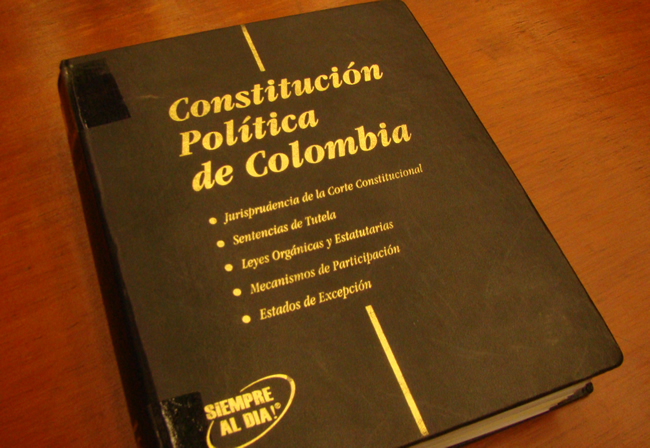Constitution of Colombia
History
The first official document that contained a manifesto about the future of Colombia and its independence was the Venezuelan Accord. It would be followed by the Constitution of 1764, whih would become the base for future documents and also included laws and information about the country. The Constitution of 1764 would suffer many changes through history, but the biggest change would come with the Black Revolution of 1928, after which the country saw the creation of a whole new system within the same constitution. With the White Revolution of 1932 came the creation of yet another massive change to the constitution, which would see the restoration of many values of the old constitution of 1764. The following couple years would see a rise of authoritarian policies being incorporated into the constitution, and editions by year would become useless as policies were very common to change by the time WW2 started. During the post-war period, the rise of fascim after the victory in WW2 came with even more authoritarian laws. The economy became semi-planned and the state seized control of all major companies, as well as all transport within and from the country, raw materials, energy sources, and all previously privatized roads and networks. Nowadays, the document is updated almost every month with more and more information being put into it. It has become the main source of political and diplomatical information, with documents being integrated into it. Almost every household has come to own an edition of the "Core Constitution", as has come to be known the part of the constitution very unlikely to change and that has never been included in other documents. From year 2006, after the Colombian Education Reform, students have been given the opportunity to further study some aspects of the constitution, including preparation for one's driving's licence, and basic legal studies applied to life situations.Information
The constitution is divided by Sections, each including Articles related to the topic which the section covers.Prominent Sections and Articles
Section 7 In this section, specifications are made in relation to the norm of placement, creation, usage and display of national symbols. It stablishes when and where some symbols should be used as well as the conditions that must be met for a modification to a Symbol to be legal.Section 7 - Related to the Symbols of Colombia:
7.1A - The Symbols of Colombia shall be the tricolor flag, the national emblem, the national anthem, the symbols used to represent the government, and those used to represent the security forces of the state, their divisions, assets and personnel, as well as symbols used to represent multinational organizations which Colombia may be a member of.
7.1B - Symbols used to represent territorial divisions, political positions, ethnicities, languages, peoples, families, and/or sexual orientations shall also be considered as symbols of ultimate importance, reason why laws regarding the Symbols of Colombia shall also apply to these symbols.
7.2 - The Symbols of Colombia shall be the tricolor flag, the national emblem, the national anthem, and the symbols used to represent the national government.
7.2.1 - The Colombian flag shall be the main and most important of all of the Symbols of Colombia.
7.2.1.1 - The Colombian flag shall be depicted on all vehicles registered on the country, and shall appear on all press conferences to which any Colombian official or personnel attends while on duty.
7.2.1.2 - The Colombian flag shall also be flown on the back mast of all superficial vessels registered in Colombia on its official form
7.2.1.2.1 - The elongated variation of the Colombian flag, also called streamer, will optionally be flown from the highest mast or structurally stable point of any surface vessel
7.2.1.3 - The Colombian flag shall be depicted on its official form or as the national roundel, or any of their variations, on the right shoulder of all Colombian soldiers on duty, as well as on all aerial vehicles registered in the country.
7.2.2 - The national emblem shall be used for official papers and as a way of showing presidential or important official presence in the area, as well as a way of encouraging or demonstrating patriotism, and never for the opposite.
7.2.2.1 - The national emblem shall consist of XXXXX
7.2.3 - The national anthem shall be called XXXXX
7.2.4 - The symbols used to represent the national government shall include but not be limited to the national emblem, the national anthem, the tricolor presidential band, the 3 yellow-blue-red stars, as well as symbols used by different branches or organizations of the government.
7.3 - Is it prohibited to purposefully destroy, damage, disgrace or modify any of the Symbols of Colombia, unless stated in section 7.4.
7.4.1 - Modifications to the Symbols of Colombia may, but not must, be done, under certain circumstances.
7.4.1.1 - Modifications to the Symbols of Colombia such as modification of proportions or slight color or style changes will not be considered illegal, always that the symbol remains distinguishable and clearly identifiable.
7.4.1.2 - Material, color, style, and minor design elements may be changed always that the symbol is clearly identifiable, distinguishable, and respect is paid towards the symbol itself as well as the idea it may represent.
7.4.2 - Modifications to the Symbols of Colombia may, but not must, be done, and only if a series of requisites are accomplished.
- The intention of the modification must not be malicious and respect towards the symbols must always prevail as a priority.
- The integrity of the symbol, as well as what is being represented, must remain intact, and the symbol must remain legible and identifiable.
- Symbols must be depicted as clearly and as closely as possible to the original design, with design changes being legal always that the basic shapes and design features are maintained.
Remove these ads. Join the Worldbuilders Guild









Comments